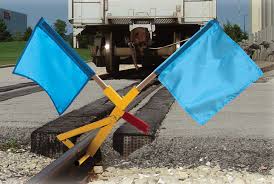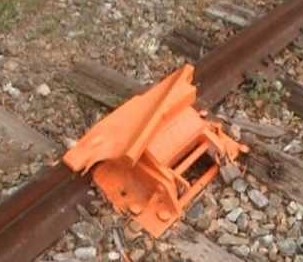Safety Comes First for Train Travel.
The more time I spend traveling by train and being around railroad people, the more aware I am of how safety is on everyone’s mind. But the day-to-day procedures are all rigorously followed because there’s just one right way to do everything.
For example, if an engineer receives confusing or garbled instructions from a dispatcher, he can refuse to move his train until he is satisfied that he understands exactly what he’s supposed to do.

Another safety practice that has always impressed me is the blue flag. You’ll see them stuck into the gravel at each end of a string of rail cars, whether passenger cars or freight cars. Actually, it’s a blue flag during the day and a blue lantern at night. It means there are men working on or under those rail cars and the rule—the inflexible rule—is that only the person who set the blue flag can remove it. No exceptions … ever.
 Sometimes you’ll see a yellow or orange device attached to a rail. It’s purpose is to prevent any rail car on a siding from accidentally rolling out onto an active track and potentially causing a collision. The derailer simply causes one of the wheels on a rolling freight car to slip off the rails and bring it to a stop.
Sometimes you’ll see a yellow or orange device attached to a rail. It’s purpose is to prevent any rail car on a siding from accidentally rolling out onto an active track and potentially causing a collision. The derailer simply causes one of the wheels on a rolling freight car to slip off the rails and bring it to a stop.
There’s a strictly enforced time limit for operating crews—engineers and conductors. They can be on duty for 12 hours and not a minute more. When a crew “goes dead”, everything stops. The cannot move the train until a relief crew arrives to take over.
Radio messages from dispatchers directing the train’s movements are carefully repeated back to the dispatcher by the engineer to be sure there is no confusion.
When the train is moving, if the engineer doesn’t adjust the speed or touch the brake or blow the whistle for a period of 25 or 30 seconds, a loud horn sounds and a strobe light starts flashing. The engineer must then press a large button in front of him on the console within a few seconds, or the train will automatically stop. This, of course, is in case the engineer should become incapacitated for any reason.
There are electronic detectors along the track every 20 or 30 miles that broadcast a warning to the engineers and conductors if a bearing in one of the wheel assemblies should be heating up.
And, just like the airlines, every locomotive is equipped with an event recorder and a video camera. In the unlikely event of an accident, this device will help determine the cause.
There’s more, but I always thought these were some of the more interesting examples.
Bottom line: don’t worry, train travel is safe.



I guess there must be a procedure to remove the blue flag, like when someone suddenly gets ill (rare, but with some 1000s of people working on the railroad daily, it’s bound to happen some times), and can’t remove it themselves, or perhaps in the case of a sabotage. It’s illegal, but I know from my experience, that at least in Europe, it’s not unheard of that during a strike, a red flag (having a similar meaning as the blue in the US) is placed on thr tracks to prevent someone from continuing to work. In those cases, a lengthy process with lots of check-ups is in place to allow the removal of the flag by someone else.